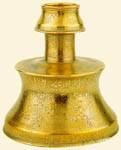|
|
| Byzantine Minor Arts |
late 13th c. Docheiariou Monastery Height 21 cm, diameter at base 19 cm |
|

|
The Docheiariou candlestick belongs to a well-represented group of cast-metal candlesticks which all share the same bell-shape body, repeated in miniature in the socket. Although the silver inlays are largely missing, the decorative pattern is still perfectly clear. Dominating the whole are the bands containing the customary inscriptions, wishing the anonymous owner prosperity and good fortune. On the socket, the inscription is in fluent Naskhi script, in the formal version used in metalwork, with anthropomorphic ending. On the neck the script is a simple fluent Naskhi, while Kufic script is used on the upper part of the body and the base. On the neck and the socket the inscriptions are punctuated by medallions with birds, on the base and the upper part of the body by rosettes. The decoration of the flat shoulder is extremely worn. The broad central zone has a series of ten consecutive lobed arches, each framing a figure, alternately standing and seated cross-legged on a low stool. The seated figures are frontal, in two cases with one hand raising a cup of wine; the standing figures are turned towards the left, in the watchful attitude of an attendant. This Sasanid-derived iconography, which symbolizes the sovereign and the life of the court and includes banquet scenes with music, dancing and wine (Baer 1983, pp. 218-45), is found, fully developed or in isolated examples, in Islamic metal-work, pottery and manuscript illumination. The decorative zones are delimited by a chain motif, and there are three basic types of background pattern: spiralling tendrils with tiny leaves and palmettes behind the upper Kufic inscription; a dense foliate arabesque between the arches; and broad three- or five-leaved palmettes within curling shoots inside the arches. This last type of pattern has been compared to the background decoration used on enamel work from Limoges and to Georgian icon revetments (Rice 1954. Stern 1957), but it is in fact closely attuned to the general current of Byzantine ornamentation as seen both in silver work and in illuminated manuscripts (Grabar 1975, figs. 3-7, 14-15, 17, 26-7. Weitzmann - Galavaris 1990, figs. 52, 278, 280, 660). The technique of inlaying silver on brass or bronze was introduced to the Near East from the eastern Iranian provinces of the Muslim world in the thirteenth century. The new art spread like wildfire, for it transformed common brassware into luxury articles well within the reach of the prosperous classes, thus to a considerable extent supplanting gold and silver articles. Characteristic of the work produced in the Near East is the blend of Islamic and Christian motifs, and the representation of subjects from everyday life. Stylistically, cast candlesticks like this one are related to the inlay work of Mosul or Syria. Recent research however identifies their source as either Iconium, the capital of the Sultanate of Rum, or northern Mesopotamia, the area referred to in Arab sources as Jazira, the chief centres of manufacture being Amida and Siirt (Allan 1982, pp. 58-69. Melikian-Chirvani 1987. Cf. also Raby 1985). When the Monastery of Docheiariou acquired this candlestick is not known, but it was probably either purchased or acquired in trade. The brotherhood of this monastery owned a ship, and traded with Saracen and African ports and with Constantinople (Actes de Docheiariou 1984, p. 14). The Monastery of St Paul, it is interesting to note, has a similar but more richly decorated candlestick, which is used as a base for its Venetian cross, thus juxtaposing two precious and contemporary articles, one imported from the East and the other from the West (see no. 9.31).
| |
|
Bibliography: Tavlakis 1982, p. 135.
| ||
| A. B. | ||
| Index of exhibits of Monastery of Docheiareiou 13th century |
||
Reference address : https://www.elpenor.org/athos/en/e218ci28.asp